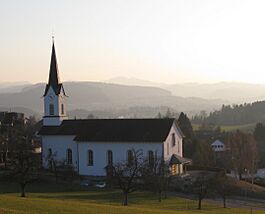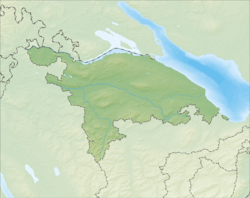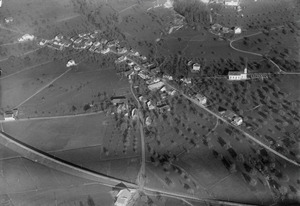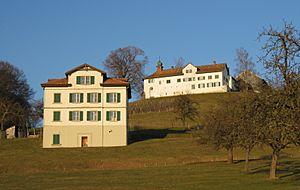Bettwiesen facts for kids
Quick facts for kids
Bettwiesen
|
||
|---|---|---|
 |
||
|
||
| Country | Switzerland | |
| Canton | Thurgau | |
| District | Münchwilen | |
| Area | ||
| • Total | 3.85 km2 (1.49 sq mi) | |
| Elevation | 550 m (1,800 ft) | |
| Population
(Dec 2020 )
|
||
| • Total | 1,228 | |
| • Density | 319.0/km2 (826.1/sq mi) | |
| Postal code |
9553
|
|
| Surrounded by | Bronschhofen (SG), Lommis, Münchwilen, Tobel-Tägerschen, Wängi | |
Bettwiesen is a small town, also called a municipality, in Switzerland. It is located in the canton of Thurgau, within the Münchwilen district. It's a lovely place with a mix of history and modern life.
Contents
History of Bettwiesen
Bettwiesen was first mentioned way back in the year 868. Back then, it was called Petterwison. During the Middle Ages (a long time ago, from about 500 to 1500 AD), the area belonged to the Prince-Bishop of Constance. A Prince-Bishop was a powerful church leader who also ruled a territory.
Later, in 1693, the whole area became part of the Fischingen monastery. A monastery is a place where monks live and work. This monastery already owned land in Bettwiesen. They even built a castle there in 1627.
The St. Mary's Chapel in Bettwiesen was first mentioned in 1275. It was part of the parish of Wil. A parish is like a church community. In 1530, the village changed its religion during the Protestant Reformation. This was a big movement that created new Christian churches. But in 1542, during the Counter-Reformation, the village went back to being Catholic.
Over time, the way people worked in Bettwiesen changed a lot. Around 1900, farming and vineyards were replaced by raising animals. A cattle bank opened in 1870, and a dairy in 1889. After 1900, factories came to town. There was an embroidery factory and later a shoe factory (from 1936 to 1979). In 1942, a special plant for coating metals opened. By 1990, many people worked in factories, and others worked in service jobs.
Geography of Bettwiesen
Bettwiesen covers an area of about 3.85 square kilometers (1.49 square miles). A big part of this land, about 63.1%, is used for farming. This means there are lots of fields and open spaces. Forests cover about 22.9% of the area. So, there are also many trees and natural areas.
About 13.8% of Bettwiesen is built up with buildings and roads. This includes homes, factories, and streets. A very small part, about 0.3%, is made up of rivers or lakes. Most of the water in Bettwiesen is flowing water, like streams.
The town is located in the Münchwilen district. Bettwiesen is known as a linear village. This means its buildings are mostly spread out along a main road.
People of Bettwiesen (Demographics)
Bettwiesen has a population of about 1,046 people. As of 2008, about 19% of the people living there were from other countries. Most people in Bettwiesen speak German, which is about 85.9% of the population. Other languages spoken include Italian (4.5%) and Albanian (4.1%).
In 2008, there were slightly more men (51.7%) than women (48.3%) living in Bettwiesen. The population is made up of different age groups. About 8.5% are children under 9 years old. Teenagers, aged 10 to 19, make up about 14.7% of the population. Adults between 20 and 59 years old make up the largest part. Older adults, aged 60 and above, make up about 15.7% of the population.
Most people in Bettwiesen live in private homes. In 2000, there were 369 households, with about 2.7 people living in each. Many homes are single-family houses. The average rent for an apartment in Bettwiesen in 2000 was about 943 Swiss francs per month.
In the 2007 national election, the most popular political party was the SVP. They received almost half of the votes. About half of the people who could vote actually did vote in that election.
Here's how the population of Bettwiesen has changed over time:
| year | population |
|---|---|
| 1850 | 296 |
| 1900 | 332 |
| 1950 | 409 |
| 1980 | 747 |
| 1990 | 986 |
| 2000 | 1,016 |
Important Buildings (Heritage Sites)
Bettwiesen Castle is a very important building. It is listed as a Swiss heritage site of national significance. This means it's a special place that is protected because of its history and cultural value.
Economy of Bettwiesen
In 2007, the unemployment rate in Bettwiesen was about 2.13%. This means a small number of people who wanted jobs couldn't find them.
The economy of Bettwiesen is divided into three main parts:
- Primary sector: This includes jobs like farming and forestry. In 2005, about 41 people worked in this area.
- Secondary sector: This includes jobs in manufacturing and construction. About 39 people worked in factories and building.
- Tertiary sector: This includes jobs in services, like shops, offices, and schools. About 102 people worked in this sector.
Many people who live in Bettwiesen travel to other towns for work. In 2000, about 52% of the people living in Bettwiesen worked outside the town. At the same time, about 90 people came into Bettwiesen to work. Most people use a private car to get to work, while some use public transportation.
Religion in Bettwiesen
Based on a census in 2000, most people in Bettwiesen are Roman Catholic, about 55.8%. The next largest group, about 22.3%, belongs to the Swiss Reformed Church. There are also people who belong to the Orthodox Church and other Christian churches. About 8.46% of the population is Islamic. Some people do not belong to any church, or are agnostic (they don't know if God exists) or atheist (they don't believe in God).
Transport in Bettwiesen
Bettwiesen is located on the Wil–Kreuzlingen railway line. This line connects the towns of Wil and Weinfelden. Bettwiesen has its own train station, called Bettwiesen railway station. It is part of the St. Gallen S-Bahn network, which is like a local train system. This makes it easy for people to travel to nearby towns.
Education in Bettwiesen
Switzerland is known for having a good education system. In Bettwiesen, many adults (about 67.2%) have finished advanced schooling. This includes either non-mandatory high school or higher education like university.
Bettwiesen has its own primary school district. In the 2008/2009 school year, there were 99 students in total.
- Kindergarten: There were 22 children in kindergarten. About 45.5% of them were girls. Some children were not Swiss citizens, and some did not speak German as their first language.
- Primary School: There were 34 children in the lower primary grades and 43 children in the upper primary grades. The average class size in primary school was about 19 students. Similar to kindergarten, some students were girls, some were not Swiss citizens, and some did not speak German natively.
See also
 In Spanish: Bettwiesen para niños
In Spanish: Bettwiesen para niños






